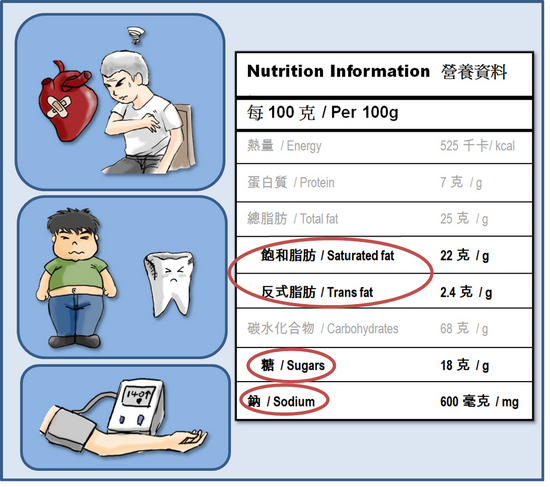
  |
Food Safety Focus (119th Issue, June 2016) – Incident in Focus
Truthful Nutrition Labels Help Make Informed Food Choice
Reported by Mr. Nicky HO, Scientific Officer,
Risk Assessment Section,
Centre for Food Safety
Recently, certain products were found non-compliant with the nutrition labelling scheme. Since the nutrition labelling scheme came into force on 1 July 2010, the compliance rate of the nutrition labelling of prepackaged food is over 98%. Among the non-compliant products, most of them were found to contain incomplete nutrition label or were identified to have discrepancies between the nutrient contents and the declared value on their nutrition labels. This article talks about the public health importance of the nutrition labelling scheme and consumers' right to make informed healthy choice.
Nutrition Labelling Scheme
To assist consumers in making informed food choices and encourage food manufacturers to apply sound nutrition principles in formulation of foods, a mandatory nutrition labelling scheme had been developed and came into force on 1 July 2010. This scheme defines the need for general prepackaged food to provide nutrition labels, with standardised format and content. Subject to statutory exemptions, information on energy and seven specified nutrients (i.e. "1+7") are required on food labels.
The seven specified nutrients are protein, carbohydrates, total fat, saturated fat, trans fat, sodium and sugars. Protein, carbohydrates, and fats are the three main groups of macro-nutrients that provide energy and are the building blocks of human body. Saturated fat and trans fat are two sub-sets of total fat, excessive consumption of which may increase the risks of developing coronary heart disease and strokes. Sugars (sub-sets of carbohydrates) provide energy for the body, but excessive intake can lead to dental caries and obesity, which is a major risk factor for a number of chronic diseases, including diabetes, cardiovascular diseases (CVDs) and cancer. Sodium is a mineral required for nerve transmission and muscle contraction, but excessive intake can lead to hypertension, and possibly life-threatening CVDs.
Accurate and truthful nutrition labels help consumer choose food with lower saturated fat, trans fat, sodium and sugars contents, so as to prevent developing associated health problems (see Figure).

Nutrients in food and their associated health problems
In order to regulate misleading or deceptive claims, the nutrition labelling scheme also stipulates specified conditions for nutrition claims. There are three main types of nutrition claims: nutrient content claim, nutrient comparative claim, and nutrient function claim.
Regulation for Formula Products and Foods for Infants and Young Children
To better protect the health of infants and young children, the Food and Drugs (Composition and Labelling) (Amendment) (No. 2) Regulation 2014 (the Amendment Regulation) expanded its scope and came into force on 13 June 2016. The Amendment Regulation comprises requirements on nutritional composition of infant formula and nutrition labelling of infant formula, follow-up formula and prepackaged foods for infants and young children.
Accurate and Truthful Nutrition Label
The nutrition information of foods can be obtained by either direct chemical analysis of food samples or indirect nutrient analysis based on calculation. Sometimes, the nutrition information of foods may be obtained from manufacturers or suppliers.
If members of the trade choose to use indirect nutrient analysis to estimate the content of nutrients in the food products, they should be aware of the limitations of indirect nutrient analysis. The trade has the onus to ensure the accuracy and suitability of the data and the method used. Compliance with the regulation on nutrition labelling would be assessed by laboratory analysis. So, the trade is encouraged to engage laboratory testing to verify their nutrition label declarations.
Key Points to Note:
- Nutrition labelling scheme covers the whole range of food from infants to adults.
- Nutrition label provides nutrition information of food products and assists consumers in making informed food choices.
- Accurate and truthful nutrition labels help consumers choose food with lower saturated fat, trans fat, sodium and sugars contents, so as to prevent developing associated health problems.
Advice to Consumers
- Use nutrition labels to choose prepackaged food with lower saturated fat, trans fat, sodium and sugars contents.
- Nutrition claims are only quick reference. Consumers are encouraged to read the nutrition label to understand the overall nutritional property of the food product for making healthy food choices.
Advice to the Trade
- Provide accurate information on food labels.
- Ensure that the nutrition information obtained from manufacturers and suppliers is accurate and truthful.
- Consider to engage laboratory testing to verify their nutrition label declarations.